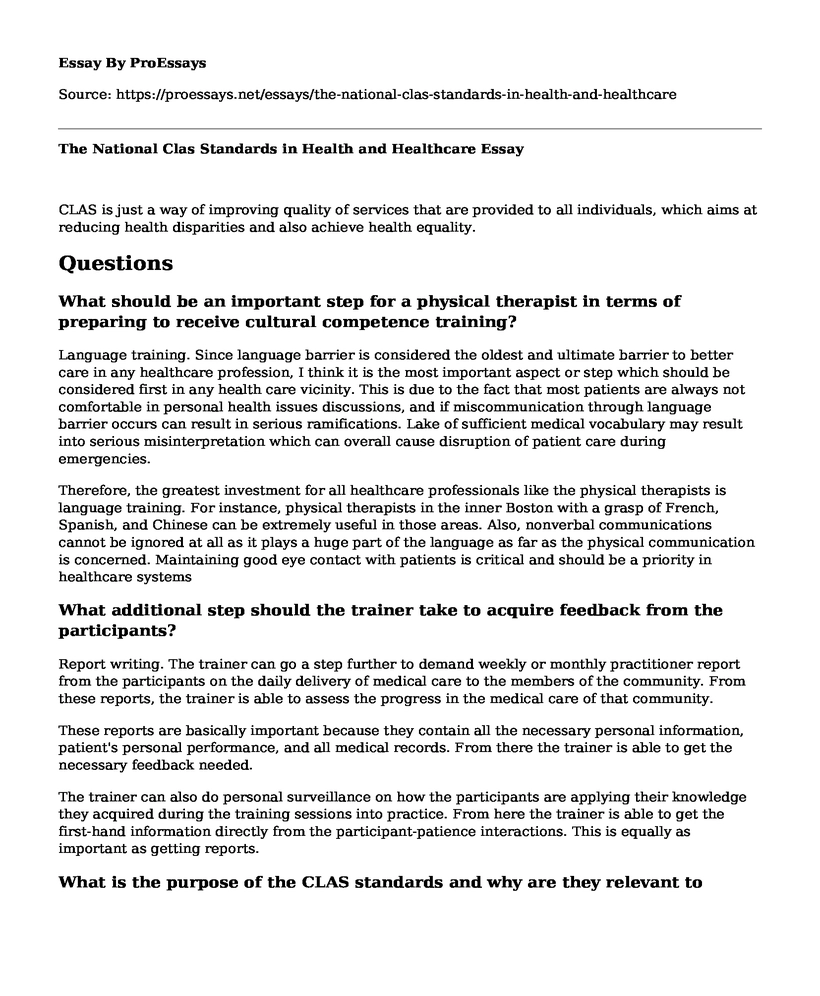CLAS is just a way of improving quality of services that are provided to all individuals, which aims at reducing health disparities and also achieve health equality.
Questions
What should be an important step for a physical therapist in terms of preparing to receive cultural competence training?
Language training. Since language barrier is considered the oldest and ultimate barrier to better care in any healthcare profession, I think it is the most important aspect or step which should be considered first in any health care vicinity. This is due to the fact that most patients are always not comfortable in personal health issues discussions, and if miscommunication through language barrier occurs can result in serious ramifications. Lake of sufficient medical vocabulary may result into serious misinterpretation which can overall cause disruption of patient care during emergencies.
Therefore, the greatest investment for all healthcare professionals like the physical therapists is language training. For instance, physical therapists in the inner Boston with a grasp of French, Spanish, and Chinese can be extremely useful in those areas. Also, nonverbal communications cannot be ignored at all as it plays a huge part of the language as far as the physical communication is concerned. Maintaining good eye contact with patients is critical and should be a priority in healthcare systems
What additional step should the trainer take to acquire feedback from the participants?
Report writing. The trainer can go a step further to demand weekly or monthly practitioner report from the participants on the daily delivery of medical care to the members of the community. From these reports, the trainer is able to assess the progress in the medical care of that community.
These reports are basically important because they contain all the necessary personal information, patient's personal performance, and all medical records. From there the trainer is able to get the necessary feedback needed.
The trainer can also do personal surveillance on how the participants are applying their knowledge they acquired during the training sessions into practice. From here the trainer is able to get the first-hand information directly from the participant-patience interactions. This is equally as important as getting reports.
What is the purpose of the CLAS standards and why are they relevant to healthcare today?
Accreditation
Accreditation bodies like the joint commission and the National Committee for Quality Assurance have formed accreditation standards which mainly focus on improving, cultural competency, communication, patient care, and also providing language assistance services.
Disparities reduction
This mainly focuses on the reduction of cost disparities. Elimination of health disparities for the marginalized minorities would reduce the cost of direct medical care expenditure by a greater percentage. For instance, a research study shows that there was a reduction of expenditure between 2003 and 2006 by $230.
Legislation
Legislation in one of the most important incentives for implementation of culturally and linguistically appropriate services. The Affordable care act contains various guidelines related to culturally and linguistically appropriate services. For instance, Title VI of the Civil Rights Act of 1964 contains detailed requirements which are related to the provision of language access services by organizations.
Improving quality services
Delivery of CLAS helps health and healthcare organizations in providing open and welcoming surroundings to groups that have previously faced barriers to care. This is vital in improving the quality services to those areas which have historically faced healthcare challenges. CLAS standards can lead to promotion of healthcare facilities such as improved hospitals and medical care in general
List and describe a minimum of three approaches that should be considered in the evaluation of training.
Engaging the leadership of an Organization
Evaluation of training requires high commitment from organization's top leaders. And therefore it is crucial to obtain leadership buy-in from the state.
Organizational assessment
Usually, CLAS assessment of an organization is completed by individuals which are identified by top leadership. The ones involved in assessment may include; planning personnel, human resource, client relations and chief executive officers. There are various assessment tools available which vary depending on the healthcare organization.
Participant identification and assessment
- They should have interest in cultural diversity and competence,
- They should also be a mix of middle to senior managers and supervisors.
References
Batinti, A. (2014). On Medical Progress and Health Care Demand: A Case Perspective Using the Grossman Model of Health Status. Health Economics, 24(12), pp.1632-1637.
Cite this page
The National Clas Standards in Health and Healthcare. (2022, Mar 29). Retrieved from https://proessays.net/essays/the-national-clas-standards-in-health-and-healthcare
If you are the original author of this essay and no longer wish to have it published on the ProEssays website, please click below to request its removal:
- Essay Sample on Reasoning in a Specialty Area
- Opioid Use Disorder Essay Example
- Coronavirus Ravages Global Financial Markets: Economic Downturn Looms - Essay Sample
- Essay on Hilton Worldwide & Coca-Cola: Targeting Middle & Senior-Aged Professionals
- Essay Example on Tai Chi: Moving Meditation for Health Benefits
- Paper Example on Beating COVID-19: Safe Practices for Prevention
- Paper Example on Fostering Inclusive Education: Leveraging Hopes & Abilities of Kids with Disabilities







